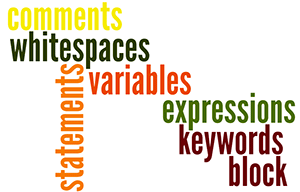
Summary: in this tutorial, you will learn about the basic Perl syntax to get started with Perl language quickly including variables, expressions, statements, block, comments, whitespaces, and keywords.
Values and Variables
You develop Perl programs to manipulate some kinds of data. The data can be either number, characters, or more complex such as a list. Data is held as value. The following examples are values:
10
20.2
"Perl syntax"Code language: Perl (perl)To hold a piece of data, you need variables. You use a variable to store a value. And through the name of the variable, you can process the value.
The following illustrates some variables in Perl:
$x = 10;
$y = 20;
$s = "Perl string";Code language: Perl (perl)We have two integer variables ( $x and $y) and one string variable ( $s). For more information on Perl variables, check it out the Perl variable tutorial.
Expressions
In Perl, an expression is anything that returns a value.
The expression can be used in a larger expression or a statement. The expression can be a literal number, complex expression with operators, or a function call.
For example, 3 is an expression that returns a value of 3. The $a + $b is an expression that returns the sum of two variables: $a and $b.
Statements
A statement is made up of expressions. A statement is executed by Perl at run-time.
Each Perl statement must end with a semicolon (;). The following example shows the statements in Perl:
$c = $a + $b;
print($c);Code language: Perl (perl)Blocks
A block is made up of statements wrapped in curly braces {}. You use blocks to organize statements in the program.
The following example illustrates a block in Perl:
{
$a = 1;
$a = $a + 1;
print($a);
}Code language: Perl (perl)Any variable declared inside a block has its own scope.
It means the variables declared inside a block only last as long as the block is executed. We will discuss more the scope of variables in the Perl variable tutorial.
Comments
In Perl, a comment begins with a hash (#) character. Perl interpreter ignores comments at both compile-time and runtime.
Typically, you use comments to document the logic of your code. The code tells you what it does however comments provides information on why the code does so.
Comments are very important and useful to you as a programmer in order to understand the code later. They’re also useful to other programmers who will read and maintain your programs in the future.
Let’s take a look at the following example:
$salary = $salary * 1.05;Code language: Perl (perl)What the code does is to increase the value of the variable $salary 5%. However, why it does so was not documented.
Therefore the following code with comment is much clearer.
# increase salary %5 for employees who achieve KPI
$salary = $salary * 1.05;Code language: Perl (perl)Perl also allows you to place a comment on the same line as the statement. See the following example:
$counter = 0; # reset the counterCode language: Perl (perl)It is important to use comments properly to make your code easier to understand.
Whitespace
Whitespaces are spaces, tabs, and newlines. Perl is very flexible in terms of whitespaces usages. Consider the following example:
$x = 20;
$y=20;Code language: Perl (perl)Both lines of code work perfectly. We surrounded the assignment operator (=) with whitespace in the first statement, but not in the second one.
Perl really doesn’t care about the whitespace. However, it is a good practice to use whitespace to make the code more readable.
Keywords
Perl has a set of keywords that have special meanings to its language.
Perl keywords fall into some categories such as built-in function and control keywords.
You should always avoid using keywords to name variables, functions, modules, and other objects. Check it out the Perl keywords.
Sometimes, it is fine to use a variable name such as $print, which is similar to the built-in print() function. However, this may lead to confusion. In addition, if the program has an issue, it’s more difficult to troubleshoot.
In this tutorial, you’ve learned the basic Perl syntax including variables, expressions, statements, block, comments, whitespaces, and keywords.